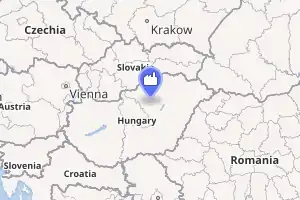Mátra Power Plant
Mátra Power Plant (Hungarian: Mátrai Erőmű Zrt.), is a lignite fired power plant majority owned by MVM, the Hungarian state owned power company since 2019.[1] It is located in the valley of the Mátra mountains, Hungary.[2] It has an installed capacity of 950 MW but 200 MW is on permanent hiatus since January 2021. According to the latest government energy strategy, most of the existing capacity will be shut down in 2025, and a new 500 MW CCGT plan will be added as well as up to 400 MW in solar power.[3]
| Mátra Power Plant | |
|---|---|
 | |
 Location in Hungary | |
| Country | Hungary |
| Location | Visonta, Heves County |
| Coordinates | 47°47′25″N 20°3′45″E |
| Status | Operational |
| Construction began | 1965 |
| Commission date | 1969 |
| Owner(s) | MVM Group |
| Thermal power station | |
| Primary fuel | Lignite |
| Secondary fuel | Natural gas |
| Power generation | |
| Units operational | 950 MW: 2 × 100 MW Lignite 1 × 212 MW Lignite 2 × 220 MW Lignite 2 × 33 MW Gas |
| Nameplate capacity |
|
| External links | |
| Website | www |
| Commons | Related media on Commons |
The Power Plant is the second largest in Hungary (after Paks Nuclear Power Plant), providing about 11% of the country's electricity production[4] (and around 8% of its consumption) in 2020. The plant was once considered an important pillar in the national energy sector because it utilizes domestic fuel unlike most other electricity plants in Hungary. However, the owner of the plant, the government decided that the current coal and gas based power generating unit is to be shut down in 2025 due to the aging generating equipment, the low quality of the local lignite, and the resulting environmental problems as well as the high emission costs.[5] In 2018, Matra produced approximately 7.9 million tonnes of lignite [6] but that decreased to around 5.5 Million tonnes by 2020 according to the company website.[7]
History up to 2010

The power plant has been operating for more than 50 years -since 1969. The lignite is extracted from the opencast mines in Visonta and Bükkábrány. The original construction project was started in 1965, when lignite field was discovered near Gyöngyös. Between 1986 and 1992 the plant was first modernized. The company was then privatized and subsequently a controlling interest was acquired by RWE in 1995.[8] The entire power station required an upgrade and retrofit program. As it emitted high levels of sulfur, flue-gas desulphurisation units were equipped to comply with EU emission standards. The units introduced were the first of their kind in the region, making the plant one of the most environmentally friendly coal-fired power plants in Europe.

Between 2005 and 2007, two of the 200 MW units were equipped with two topping gas turbines (TBT), each with a maximum of 33 MW capacity, which improved efficiency. The performance of the coal block increased by about 10%, which accounts for a total power output increase of about 100 MW. There were also plans for an additional block to be built, but in late 2010, the project was cancelled.[9]
The chimney with a height of 203 meters is the 8th tallest buildings in Hungary.
References
- "Cegadatok". Retrieved 2021-06-08.
- "EUROPA - Press Releases - European Commission approves "coal package" authorizing restructuring plans for the Polish, German and Hungarian coal industry until 2010". Retrieved 2011-03-02.
- "Gazra allitjak at a Matrai Eromuvet". Retrieved 2021-06-08.
- "Villamos energia eves adatok 2014-2020". Retrieved 2021-07-18.
- "Gazra allitjak at a Matrai Eromuvet". Retrieved 2021-06-08.
- "Euracoal Hungary profile". Retrieved 2021-07-01.
- "Tevekenyseg". Retrieved 2021-07-01.
- "RWE extended the life of Hungary's Matra power station" (PDF). Retrieved 2014-11-10.
- "The new block has no future". Retrieved 2011-03-02.
External links
- Website
- at Global Energy Monitor